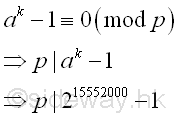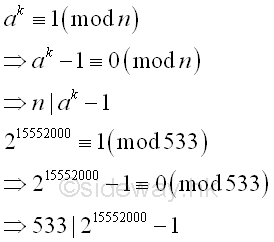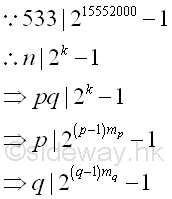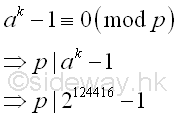|
Link:http://output.to/sideway/default.asp?qno=120500008 Pollard's p-1 Method
Pollard's p-1 Method
Pollard's p-1 method is a prime factorization algorithm
discovered by John Pollard
in 1974. Limited by the algorithm, the Pollard's p-1 method is only work for
integers with specific factors.
However, since the composite number n is an unknown, sometimes, the algorithm
may return a false response.
Characteristic of Pollard's p-1 Method by Smooth Number
The advantage of Pollard's p-1 method by smooth number is the checking of a
group of primes with one computation. Every boundary B represents a group
of numbers that can be expressed as the product of primes less than and
equal to number B.
For example, a composite number n less than 10000 should have a prime factor
less than √n=100. And primes within 100 are
| Primes |
Integer |
B-smooth |
count |
| 2, 3, 5, 7, 11, 13, 17, 19, 23, 29, 31, 37, 41, 43, 47,
53, 59, 61, 67, 71, 73, 79, 83, 89, 97 |
p |
|
25 |
| 2, 3, 5, 17 |
p-1 |
2 |
4 |
| 2, 3, 5, 7, 13, 17, 19, 37, 73, 97 |
p-1 |
3 |
10 |
| 2, 3, 5, 7, 11, 13, 17, 19, 31, 37, 41, 61, 73, 97 |
p-1 |
5 |
14 |
| 2, 3, 5, 7, 11, 13, 17, 19, 29, 31, 37, 41, 43, 61,
71, 73, 97 |
p-1 |
7 |
17 |
| 2, 3, 5, 7, 11, 13, 17, 19, 23, 29, 31, 37, 41, 43,
61, 67, 71, 73, 89, 97 |
p-1 |
11 |
20 |
| 2, 3, 5, 7, 11, 13, 17, 19, 23, 29, 31, 37, 41, 43, 53,
61, 67, 71, 73, 79, 89, 97 |
p-1 |
13 |
22 |
| 2, 3, 5, 7, 11, 13, 17, 19, 23, 29, 31, 37, 41, 43, 53,
61, 67, 71, 73, 79, 89, 97 |
p-1 |
17 |
22 |
| 2, 3, 5, 7, 11, 13, 17, 19, 23, 29, 31, 37, 41, 43, 53,
61, 67, 71, 73, 79, 89, 97 |
p-1 |
19 |
22 |
| 2, 3, 5, 7, 11, 13, 17, 19, 23, 29, 31, 37, 41, 43, 47,
53, 61, 67, 71, 73, 79, 89, 97 |
p-1 |
23 |
23 |
| 2, 3, 5, 7, 11, 13, 17, 19, 23, 29, 31, 37, 41, 43, 47,
53, 59, 61, 67, 71, 73, 79, 89, 97 |
p-1 |
29 |
24 |
| 2, 3, 5, 7, 11, 13, 17, 19, 23, 29, 31, 37, 41, 43, 47,
53, 59, 61, 67, 71, 73, 79, 89, 97 |
p-1 |
31 |
24 |
| 2, 3, 5, 7, 11, 13, 17, 19, 23, 29, 31, 37, 41, 43, 47,
53, 59, 61, 67, 71, 73, 79, 89, 97 |
p-1 |
37 |
24 |
| 2, 3, 5, 7, 11, 13, 17, 19, 23, 29, 31, 37, 41, 43, 47,
53, 59, 61, 67, 71, 73, 79, 83, 89, 97 |
p-1 |
41 |
25 |
| 2, 3, 5, 7, 11, 13, 17, 19, 23, 29, 31, 37, 41, 43, 47,
53, 59, 61, 67, 71, 73, 79, 83, 89, 97 |
p-1 |
43 |
25 |
| 2, 3, 5, 7, 11, 13, 17, 19, 23, 29, 31, 37, 41, 43, 47,
53, 59, 61, 67, 71, 73, 79, 83, 89, 97 |
p-1 |
47 |
25 |
More primes can be included for checking by increasing the smoothness boundary
B.
For checking n and ak-1 is divisible by p, k is
selected sufficiently large to ensure p-1 divides k, If the specific type prime
factor is less than กิn, in the worst case, the smoothness boundary B can
be equal to 41.
However, since the composite number n is an unknown, sometimes, the algorithm
may return a false response. For example:
Pollard's P-1 Methed by Smooth Number Example 3
For example: n=533=p*q=13*41; let B=5 imply
| Integer |
B-smooth number |
Prime Factors |
number |
| k |
5 |
29*35*53
= 512*243*125 |
15552000 |
Therefore for B=5, k5 or (p5-1)m5 is equal to 15552000.
Fermat's Little Theorem
let a=2, by Fermat's little theorem,
let p be one of the prime factors of n, imply p divides ak-1.

Greatest Common Divisor
Since ak-1 is a very large number, before finding the
greatest common divisor of n and ak-1, ak-1 can be raised to the high power modulo n. Imply
Using squarings modulo
| base |
number; a=2; k=15552000; n=533 |
| ak base 10 |
215552000 |
| ai base 10 |
21 = 21 ก
2 (mod 533) |
| 22 = 22 ≡ 4 (mod
533) |
| 24 = 42 ≡ 16 (mod
533) |
| 28 = 162 ≡
256 (mod 533) |
| 216 = 2562 ≡
510 (mod 533) |
| 232 = 5102 ≡
529 (mod 533) |
| 264 = 5292 ≡
16 (mod 533) |
| 2128 = 162 ≡
256 (mod 533) |
| 2256 = 2562 ≡
510 (mod 533) |
| 2512 = 5102 ≡
529 (mod 533) |
| 21024 = 5292 ≡
16 (mod 533) |
| 22048 = 162 ≡
256 (mod 533) |
| 24096 = 2562 ≡
510 (mod 533) |
| 28192 = 5102 ≡
529 (mod 533) |
| 216384 = 5292 ≡
16 (mod 533) |
| 232768 = 162 ≡
256 (mod 533) |
| 265536 = 2562 ≡
510 (mod 533) |
| 2131072 = 5102 ≡
529 (mod 533) |
| 2262144 = 5292 ≡
16 (mod 533) |
| 2524288 = 162 ≡
256 (mod 533) |
| 21048576 = 2562 ≡
510 (mod 533) |
| 22097152 = 5102 ≡
529 (mod 533) |
| 24194304 = 5292 ≡
16 (mod 533) |
| 28388608 = 162 ≡
256 (mod 533) |
| 216777216 = 5092 ≡
285 (mod 533) |
| 233554432 = 2852 ≡
518 (mod 533) |
| 267108864 = 5182 ≡
190 (mod 533) |
| ak base 10 |
28388608+4194304+2097152+524288+262144+65536+16384+2048+1024+512 |
| ak base 10 |
28388608*24194304*22097152*2524288*2262144*
265536*216384*22048*21024*2512 |
| ak base 10 |
256*16*529*256*16*510*16*256*16*529 ≡
1 (mod 533) |
Imply

The algorithm returns a fail response, because the number n divides ak-1
and n is the greatest common divisor of n and ak-1.
Imply

Therefore every prime factor of number n divides ak-1,
imply

Since k is a very large number, usually the algorithm fails because k is the multiple of
the product of p-1 and q-1, imply

One way is to select a smaller k so that k is not the common multiple
of both p-1 and q-1. Let B=3, Imply
| Integer |
B-smooth number |
Prime Factors |
number |
| k |
3 |
29*35
= 512*243 |
124416 |
Therefore for B=3, k3 or (p3-1)m3 is equal to 124416.
Fermat's Little Theorem
let a=2, by Fermat's little theorem,
let p be one of the prime factors of n, imply p divides ak-1.

Greatest Common Divisor
Since ak-1 is a very large number, before finding the
greatest common divisor of n and ak-1, ak-1 can be raised to the high power modulo n. Imply
Using squarings modulo
| base |
number; a=2; k=124416; n=533 |
| ak base 10 |
2124416 |
| ai base 10 |
21 = 21 ก
2 (mod 533) |
| 22 = 22 ≡ 4 (mod
533) |
| 24 = 42 ≡ 16 (mod
533) |
| 28 = 162 ≡
256 (mod 533) |
| 216 = 2562 ≡
510 (mod 533) |
| 232 = 5102 ≡
529 (mod 533) |
| 264 = 5292 ≡
16 (mod 533) |
| 2128 = 162 ≡
256 (mod 533) |
| 2256 = 2562 ≡
510 (mod 533) |
| 2512 = 5102 ≡
529 (mod 533) |
| 21024 = 5292 ≡
16 (mod 533) |
| 22048 = 162 ≡
256 (mod 533) |
| 24096 = 2562 ≡
510 (mod 533) |
| 28192 = 5102 ≡
529 (mod 533) |
| 216384 = 5292 ≡
16 (mod 533) |
| 232768 = 162 ≡
256 (mod 533) |
| 265536 = 2562 ≡
510 (mod 533) |
| ak base 10 |
265536+32768+16384+8192+1024+512 |
| ak base 10 |
265536*232768*216384*28192*21024*2512 |
| ak base 10 |
510*256*16*529*16*529 ≡
469 (mod 533) |
Imply

The
greatest common divisor of n and ak-1 is
Using Euclid's algorithm
| ak-1 |
n |
| 2124416-1 |
533 |
| 469-1 |
533 |
| 468 |
533-468=65 |
| 468-7*65=13 |
65 |
| 13 |
65-5*13=0 |
| 13 |
0 |
Imply

Integer 13, the
greatest common divisor of n and ak-1 is also the
prime divisor of n. And p-1 is 3-smooth.
| Integer |
B-smooth number |
Prime Factors |
number |
| p-1 |
3 |
22*31 |
12 |
| k |
3 |
29*35
= 512*243 |
124416 |
| k/(p-1) |
|
27*34 |
10368 |
Besides, for B=5
| Integer |
B-smooth number |
Prime Factors |
number |
| p-1 |
3,5 |
22*31 |
12 |
| q-1 |
5 |
23*51 |
40 |
| k5 |
5 |
29*35*53 = 512*243*125 |
15552000 |
| k5/(p-1)(q-1) |
|
24*34*52 |
32400 |
|
|
 Sideway
BICK BLOG from Sideway
Sideway
BICK BLOG from Sideway








